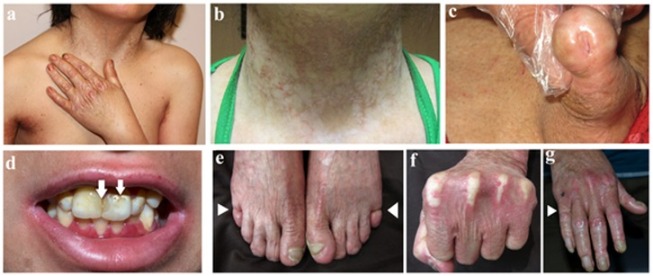
Kindler syndrome is a rare type of epidermolysis bullosa, which is a group of genetic conditions that cause the skin to be very fragile and to blister easily.
From early infancy, people with Kindler syndrome have skin blistering, particularly on the backs of the hands and the tops of the feet. The blisters occur less frequently over time, although repeated blistering on the hands can cause scarring that fuses the skin between the fingers and between the toes. Affected individuals also develop thin, papery skin starting on the hands and feet and later affecting other parts of the body.
Other skin abnormalities that occur with Kindler syndrome include patchy changes in skin coloring and small clusters of blood vessels just under the skin (telangiectases), a combination known as poikiloderma. In some affected individuals, the skin on the palms of the hands and soles of the feet thickens and hardens (hyperkeratosis). Kindler syndrome can also cause people to be highly sensitive to ultraviolet (UV) rays from the sun and to sunburn easily.
Kindler syndrome can also affect the moist lining (mucosae) of the mouth, eyes, esophagus, intestines, genitals, and urinary system, causing these tissues to be very fragile and easily damaged. Affected individuals commonly develop severe gum disease that can lead to early tooth loss. The moist tissues that line the eyelids and the white part of the eyes (the conjunctiva) can become inflamed (conjunctivitis), and damage to the clear outer covering of the eye (the cornea) can affect vision.
Narrowing (stenosis) of the esophagus, which is the tube that carries food from the mouth to the stomach, causes difficulty with swallowing that worsens over time. Some affected individuals develop health problems related to inflammation of the colon (colitis) or damage to the mucosa in the vagina, the anus, or the tube that carries urine from the bladder out of the body (the urethra).
Kindler syndrome increases the risk of developing a form of cancer called squamous cell carcinoma. This type of cancer arises from squamous cells, which are found in the outer layer of skin (the epidermis) and in the mucosae. In people with Kindler syndrome, squamous cell carcinoma occurs most often on the skin, lips, and the lining of the mouth (oral mucosa).
- Ashton GH, McLean WH, South AP, Oyama N, Smith FJ, Al-Suwaid R, Al-Ismaily A, Atherton DJ, Harwood CA, Leigh IM, Moss C, Didona B, Zambruno G, Patrizi A, Eady RA, McGrath JA. Recurrent mutations in kindlin-1, a novel keratinocyte focal contact protein, in the autosomal recessive skin fragility and photosensitivity disorder, Kindler syndrome. J Invest Dermatol. 2004 Jan;122(1):78-83.
- Has C, Castiglia D, del Rio M, Diez MG, Piccinni E, Kiritsi D, Kohlhase J, Itin P, Martin L, Fischer J, Zambruno G, Bruckner-Tuderman L. Kindler syndrome: extension of FERMT1 mutational spectrum and natural history. Hum Mutat. 2011 Nov;32(11):1204-12. doi: 10.1002/humu.21576. Epub 2011 Sep 20. Review.
- Jobard F, Bouadjar B, Caux F, Hadj-Rabia S, Has C, Matsuda F, Weissenbach J, Lathrop M, Prud'homme JF, Fischer J. Identification of mutations in a new gene encoding a FERM family protein with a pleckstrin homology domain in Kindler syndrome. Hum Mol Genet. 2003 Apr 15;12(8):925-35.
- Lai-Cheong JE, McGrath JA. Kindler syndrome. Dermatol Clin. 2010 Jan;28(1):119-24. doi: 10.1016/j.det.2009.10.013. Review.
- Siegel DH, Ashton GH, Penagos HG, Lee JV, Feiler HS, Wilhelmsen KC, South AP, Smith FJ, Prescott AR, Wessagowit V, Oyama N, Akiyama M, Al Aboud D, Al Aboud K, Al Githami A, Al Hawsawi K, Al Ismaily A, Al-Suwaid R, Atherton DJ, Caputo R, Fine JD, Frieden IJ, Fuchs E, Haber RM, Harada T, Kitajima Y, Mallory SB, Ogawa H, Sahin S, Shimizu H, Suga Y, Tadini G, Tsuchiya K, Wiebe CB, Wojnarowska F, Zaghloul AB, Hamada T, Mallipeddi R, Eady RA, McLean WH, McGrath JA, Epstein EH. Loss of kindlin-1, a human homolog of the Caenorhabditis elegans actin-extracellular-matrix linker protein UNC-112, causes Kindler syndrome. Am J Hum Genet. 2003 Jul;73(1):174-87. Epub 2003 Jun 3.
- Youssefian L, Vahidnezhad H, Uitto J. Kindler Syndrome. 2016 Mar 3 [updated 2016 Dec 1]. In: Pagon RA, Adam MP, Ardinger HH, Wallace SE, Amemiya A, Bean LJH, Bird TD, Ledbetter N, Mefford HC, Smith RJH, Stephens K, editors. GeneReviews® [Internet]. Seattle (WA): University of Washington, Seattle; 1993-2017. Available from www.ncbi.nlm.nih.gov/books/NBK349072/.



No comments
Post a Comment